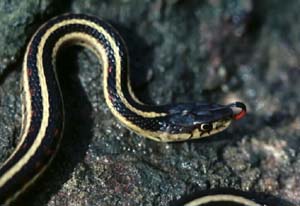|
Common Garter Snake (Thamnophis sirtalis) - Wiki
| 제목: | Common Garter Snake (Thamnophis sirtalis) - Wiki
| |

| 해상도: 300x206
파일크기: 13861 Bytes
등록시간: 2007:10:05 14:06:20
|
Common Garter Snake
From Wikipedia, the free encyclopedia
[Photo] From http://www.nps.gov/wica/Red-Sided_Garter_Snake.htm (a National Park Service web site). The image shows a Red-sided Garter Snake (Thamnophis sirtalis parietalis), a subspecies of the Common Garter Snake. License: public domain
The Common Garter Snake (Thamnophis sirtalis) is a non-venomous snake indigenous to North America. Most garter snakes have a pattern of yellow stripes on a brown background and their average length is about 1-1.5 metres (2-3.5 ft). Like all other snakes, garter snakes use their tongue to smell.
Habitat
The habitat of the garter snake ranges from forests, fields and prairies to streams, wetlands, meadows, marshes and ponds, and they are often found near water. They are semi-aquatic animals like most snakes. Habitats range from sea level to mountain locations. Their diet consists mainly of amphibians and earthworms, but also fish, small birds, and rodents. Compared to the more aquatic species, garter snakes are not especially effective at catching fish. The animals that eat the common garter snake are large fish, bull frogs, snapping turtles, milk snakes, hawks, skunks, and foxes.
Reproduction
Garter snakes do not sex
Life history
The common garter snake is a diurnal snake. In summer, it is most active in the morning and late afternoon; in cooler seasons or climates, it restricts its activity to the warm afternoons.
In warmer southern areas, the snake is active year-round; otherwise, it hibernates in common dens, sometimes in great numbers. On warm winter afternoons, some snakes have been observed emerging from their hibernacula to bask in the sun.
Garter snakes generally mate in March or April, after hibernation. The species is ovoviviparous; females give birth to a litter of 12-40 live young anytime from July through October.
Toxicity
The saliva of a garter snake may be toxic to amphibians and other small animals. For humans, a bite is not dangerous but may produce a swelling or a burning rash. Most garter snakes also secrete a foul-smelling fluid from postanal glands when handled or harmed. Like any predator they are highly unpredictable.
Ecology
Water contamination, urban expansion, and residential and industrial development are all threats to the garter snake’s species. The San Francisco Garter Snake (T.s. tetrataenia), which is extremely scarce and occurs only in the vicinity of ponds and reservoirs in San Mateo County, California, has been listed as an endangered species by the U.S. Fish and Wildlife Service since 1967.
Garter snakes can make excellent pets because they are small, easily kept in terrariums and feed readily on goldfish and other commercially available live foods. It is advisable not to give a steady diet of earthworms/nightcrawlers since these lack sufficient vitamins for the snake's health. Although they are usually found near water, the pet habitat must be dry with only a water bowl to avoid serious skin diseases. This is true of all snake species, including water snakes
Care as pets
If you own a common garter snake as a pet, a 10-15 gallon tank should be enough for one snake. Adding a small tub of clean, de-chlorinated water to this tank allows the snake to drink and swim. This water should be changed about every week to prevent dirt and other material from being swallowed by the snake. Feeding is simple and only involves adding 2-4 rinsed earthworms (dirt on the worms may make the snake sick) to the tub.The snake may also eat guppies.
Taxonomy
Current scientific classification recognizes thirteen subspecies:
T.s. sirtalis Linnaeus 1758: Common Garter Snake
T.s. parietalis Say 1823: Red-sided Garter Snake. Has also been introduced to northern Halland in Sweden, where it thrives.
T.s. infernalis Blainville 1835: California Red-sided Garter Snake
T.s. concinnus Hallowell 1852:Red-spotted Garter Snake
T.s. dorsalis Baird and Girard 1853: New Mexico Garter Snake
T.s. pickeringii Baird and Girard 1853: Puget Sound Garter Snake
T.s. tetrataenia Cope 1875: San Francisco Garter Snake; endangered
T.s. semifasciatus Cope 1892: Chicago Garter Snake
T.s. pallidulus Allen 1899: Maritime Garter Snake
T.s. annectens Brown 1950: Texas Garter Snake
T.s. fitchi Fox 1951: Valley Garter Snake
T.s. similis Rossman 1965: Blue-striped Garter Snake
T.s. butleri Cope 1889: Butler's Garter Snake
http://en.wikipedia.org/wiki/Common_Garter_Snake
| The text in this page is based on the copyrighted Wikipedia article shown in above URL. It is used under the GNU Free Documentation License. You may redistribute it, verbatim or modified, providing that you comply with the terms of the GFDL. |
|
^o^
동물그림창고 똑똑전화 누리집
^o^
|
|